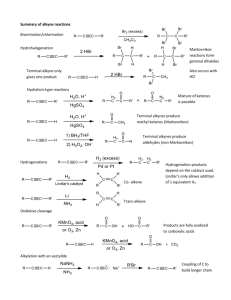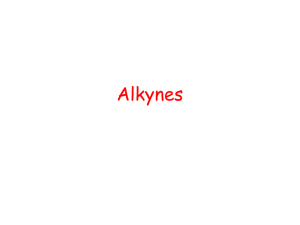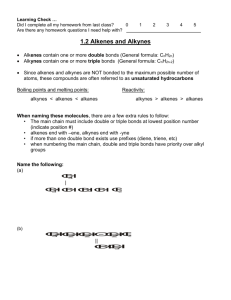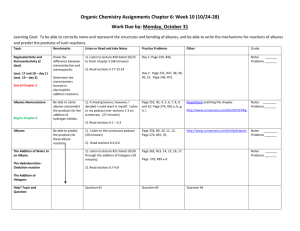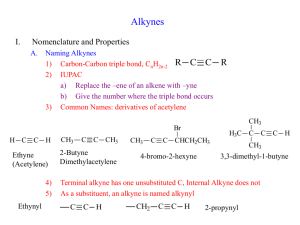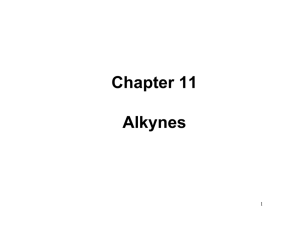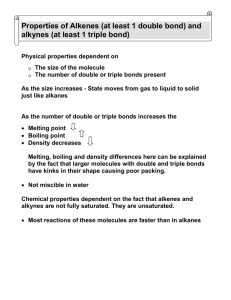Chapter 11
advertisement
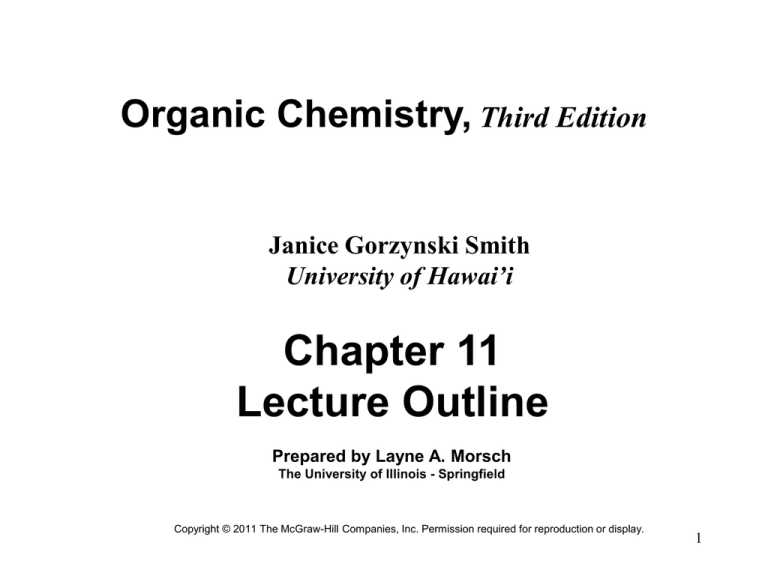
Organic Chemistry, Third Edition Janice Gorzynski Smith University of Hawai’i Chapter 11 Lecture Outline Prepared by Layne A. Morsch The University of Illinois - Springfield Copyright © 2011 The McGraw-Hill Companies, Inc. Permission required for reproduction or display. 1 Alkyne Structure • Alkynes contain a carbon-carbon triple bond. • An alkyne has the general molecular formula CnH2n−2, giving it four fewer hydrogens than the maximum possible for the number of carbons present. • The triple bond introduces two degrees of unsaturation. • Terminal alkynes have the triple bond at the end of the carbon chain so that a hydrogen atom is directly bonded to a carbon atom of the triple bond. • Internal alkynes have a carbon atom bonded to each carbon atom of the triple bond. 2 Alkyne Bonding • Recall that the triple bond consists of 2 bonds and 1 bond. • Each carbon is sp hybridized with a linear geometry and bond angles of 180o. 3 Strength of Alkyne Bonds • Bond dissociation energies of the C − C bonds in ethylene (one and one bond) and acetylene (one and two bonds) can be used to estimate the strength of the second bond of the triple bond. 4 Cyclic Alkynes • Like trans cycloalkenes, cycloalkynes with small rings are unstable. • The carbon chain must be long enough to connect the two ends of the triple bond without introducing too much strain. • Cyclooctyne is the smallest isolated cycloalkyne, though it decomposes upon standing at room temperature after a short time. 5 Naming Alkynes • Alkynes are named in the same general way that alkenes are named. • In the IUPAC system, change the –ane ending of the parent alkane name to the suffix –yne. • Choose the longest continuous chain that contains both atoms of the triple bond and number the chain to give the triple bond the lower number. 6 Naming Alkynes • Compounds with two triple bonds are named as diynes, those with three are named as triynes and so forth. • Compounds with both a double and triple bond are named as enynes. • The chain is numbered to give the first site of unsaturation (either C=C or CC) the lower number. Figure 11.1 7 Physical Properties of Alkynes • The physical properties of alkynes resemble those of hydrocarbons of similar shape and molecular weight. • Alkynes have low melting points and boiling points. • Melting point and boiling point increase as the number of carbons increases. • Alkynes are soluble in organic solvents and insoluble in water. 8 Acetylene • The simplest alkyne, H−CC−H, named in the IUPAC system as ethyne, is more often called acetylene, its common name. • The two-carbon alkyl group derived from acetylene is called an ethynyl group. • Acetylene (H−CC−H) is a colorless gas that burns in oxygen to form CO2 and H2O. • The combustion of acetylene releases more energy per mole of product formed than any other hydrocarbons. • When combined with oxygen, it burns with a very hot flame and is used in welding. 9 Oral Contraceptives Figure 11.2 10 Oral Contraceptives • RU-486 and levonorgestrel are two other synthetic hormones. • RU-486 blocks the effects of progesterone, thus preventing pregnancy. • It is used to induce abortions within the first few weeks of pregnancy. • Levonorgestrel interferes with ovulation, and so it prevents pregnancy if taken within a few days of unprotected sex. 11 Histrionicotoxin Figure 11.3 12 Preparation of Alkynes • Alkynes are prepared by elimination reactions. • A strong base removes two equivalents of HX from a vicinal or geminal dihalide to yield an alkyne through two successive E2 elimination reactions. 13 Preparation of Alkynes from Alkenes • Since vicinal dihalides are readily made from alkenes, one can convert an alkene to the corresponding alkyne in a two-step process involving: • Halogenation of an alkene. • Double dehydrohalogenation of the resulting vicinal dihalide. 14 General Addition Reactions of Alkynes • Like alkenes, alkynes undergo addition reactions because they contain relatively weak bonds. • Two sequential reactions can take place: addition of one equivalent of reagent forms an alkene, which can then add a second equivalent of reagent to yield a product having four new bonds. 15 Addition Reactions of Alkynes Figure 11.5 16 Hydrohalogenation—Electrophilic Addition of HX • Alkynes undergo hydrohalogenation, i.e., the addition of hydrogen halides, HX (X = Cl, Br, I). • Two equivalents of HX are usually used: addition of one mole forms a vinyl halide, which then reacts with a second mole of HX to form a geminal dihalide. 17 Hydrohalogenation—Markovnikov’s Rule 18 Hydrohalogenation Mechanism 19 Hydrohalogenation of Alkynes vs. Alkenes • Electrophilic addition of HX to alkynes is slower than electrophilic addition of HX to alkenes, even though alkynes are more polarizable and have more loosely held electrons than alkenes. • Markovnikov addition in step [3] places the H on the terminal carbon to form the more substituted carbocation A, rather than the less substituted carbocation B. 20 Halogen Stabilization of Carbocations • Resonance stabilizes a molecule by delocalizing charge and electron density. • Halogens stabilize an adjacent positive charge by resonance. • Carbocation A is stabilized by resonance. 21 Halogenation of Alkynes • Halogens X2 (X = Cl or Br) add to alkynes just as they do to alkenes. • Addition of one mole of X2 forms a trans dihalide, which can then react with a second mole of X2 to yield a tetrahalide. 22 Halogenation Mechanism 23 Hydration of Alkynes • In the presence of strong acid or Hg2+ catalyst, the elements of H2O add to the triple bond to form an enol initially. • The enol is unstable and rearranges to a ketone. 24 Hydration of Internal vs. Terminal Alkynes • Internal alkynes undergo hydration with concentrated acid to form ketones. • Terminal alkynes require the presence of an additional Hg2+ catalyst (usually HgSO4) to yield methyl ketones by Markovnikov addition of water. 25 Keto-Enol Tautomerization • Tautomers are constitutional isomers that differ in the location of a double bond and a hydrogen atom. • A and B are tautomers: A is the enol form and B is the keto form of the tautomer. • An enol tautomer has an O−H group bonded to a C=C. • A keto tautomer has a C=O and an additional C−H bond. • Equilibrium favors the keto form largely because the C=O is much stronger than a C=C. • Tautomerization, the process of converting one tautomer into another, is catalyzed by both acid and base. 26 Tautomerization Mechanism 27 Hydration Mechanism 28 Hydroboration−Oxidation of Alkynes • Hydroboration−oxidation is a two-step reaction sequence that also converts an alkyne to a carbonyl compound. • • • • Addition of borane forms an organoborane. Oxidation with basic H2O2 forms an enol. Tautomerization of the enol forms a carbonyl compound. The overall result is addition of H2O to a triple bond. 29 Hydroboration−Oxidation of Internal vs. Terminal Alkynes • Hydroboration−oxidation of an internal alkyne forms a ketone, just as the acid-catalyzed hydration did. • However, hydroboration−oxidation of a terminal alkyne forms an aldehyde. • BH2 adds to the less substituted, terminal carbon resulting in anti-Markovnikov addition of water. 30 Formation of Acetylide Ions • Sp hybridized C − H bonds are considerably more acidic than sp2 and sp3 hybridized C − H bonds. • Therefore, terminal alkynes are readily deprotonated with strong base in a Brønsted-Lowry acid-base reaction. • The resulting ion is called the acetylide ion. 31 Formation of Acetylide Ions 32 Reactions of Acetylide Ions • Acetylide anions are strong nucleophiles and react with unhindered alkyl halides to yield products of nucleophilic substitution. • The mechanism of substitution is SN2, and thus the reaction is fastest with CH3X and 1o alkyl halides. 33 Elimination vs. Substitution with Acetylide Ions • Steric hindrance around the leaving group causes 2° and 3° alkyl halides to preferentially undergo elimination by an E2 mechanism, as shown with 2-bromo-2-methylpropane. • Thus, nucleophilic substitution with acetylide anions forms new carbon-carbon bonds in high yield only with unhindered CH3X and 1° alkyl halides. 34 Synthesis Using Acetylide Ions • Carbon-carbon bond formation with acetylide anions is a valuable reaction used in the synthesis of numerous natural products. Figure 11.6 35 Reactions of Acetylide Ions with Epoxides • Acetylide anions are strong nucleophiles that open epoxide rings by an SN2 mechanism. • Backside attack occurs at the less substituted end of the epoxide. 36 Synthesis Using Alkynes • You can now begin to consider (for example) how to prepare a five-carbon product from three smaller precursor molecules using the reactions you have learned. • To plan a synthesis of more than one step, we use the process of retrosynthetic analysis—that is, working backwards from a desired product to determine the starting materials from which it is made. 37 Retrosynthetic Analysis • Retrosynthetic analysis is the method of working backwards from a target compound to starting materials. • To write a synthesis working backwards, an open arrow () is used to indicate that the product is drawn on the left and the starting material on the right. • In designing a synthesis, reactions are often divided into two categories: 1. Those that form new carbon-carbon bonds. 2. Those that convert one functional group into another—that is, functional group interconversions. 38 Example of a Retrosynthetic Synthesis • Devise a synthesis of the following compound from starting materials having two carbons or fewer. • Thinking backwards . . . [1] [2] [3] Form the carbonyl group by hydration of a triple bond. Form a new C-C bond using an acetylide anion and a 1° alkyl halide (two 2-carbon structures are converted to a 4-carbon product). Prepare the acetylide anion from acetylene by treatment with base. 39 Steps to Develop a Retrosynthetic Analysis 40
